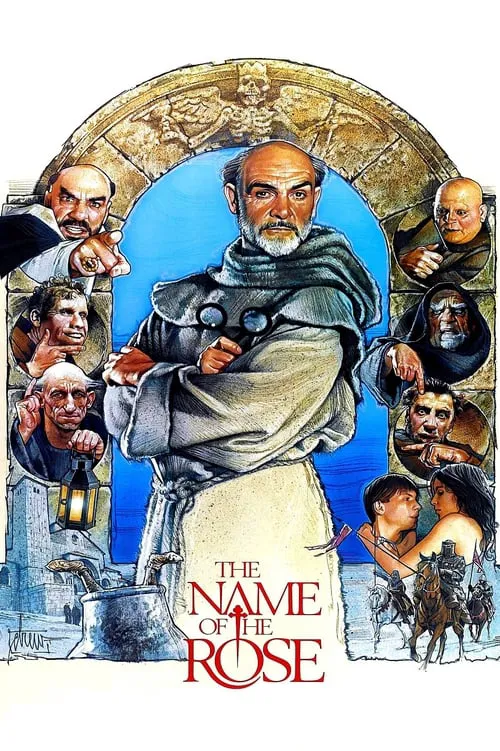The Name of the Rose

Plot
In the late 14th century, the year 1327, a gathering of high-ranking Franciscan and Dominican monks takes place at the abbey in the medieval Italian town of Northern Umbria. Among the attendees is the erudite and astute William of Baskerville, a Franciscan friar from England, accompanied by his young novice, Adso of Melk. Adso, who would go on to become a renowned historian, is tasked with chronicling the events of their visit, which would become a testament to the extraordinary intellectual prowess of William. Upon their arrival, the pair is met by the abbey's prior, a man named Jorge of Burgos, who is accompanied by several other senior monks. Jorge's demeanor is anything but warm and welcoming, instead exuding an aura of suspicion and hostility. Little does William suspect that their stay at the abbey would quickly turn into a murder mystery that would unravel a dark web of secrets, deceit, and conspiracy. As the conference commences, a series of gruesome murders takes place during the night, with each victim bearing marks of strangulation, a peculiar sign in the form of a wound resembling a claw mark, left on the throat. William, aware of his vast knowledge in logic, philosophy, and observation, becomes intrigued by the cryptic signs and the apparent randomness of the killings. Recognizing that the murders might be linked to a deeper agenda, William resolves to investigate the crimes, convinced that rational inquiry and logical reasoning can unravel the truth behind the gruesome events. Adso, initially perplexed by the unfolding events, finds himself drawn into his mentor's investigation, learning about various fields of study, including Aristotelian philosophy, and observing William's deductive reasoning at work. The novice monk's eagerness to learn complements William's inquisitive nature, creating an inseparable partnership that would navigate the complex labyrinth of the abbey's intricate social structure and the mysterious circumstances surrounding the murders. The pair begins to interview the various monks and novices, gathering information about the potential motives behind the murders. They speak with a group of Benedictine monks who are not part of the main order attending the gathering; the latter is made aware that the murder may be linked to an ancient manuscript on Aristotle and its connection to the Church dogma of time. One of the key players they interview is Ubertino of Casale, a charismatic and ambitious figure, who becomes an ally in their investigation. However, their conversation with Ubertino highlights the depth of tension among the attendees, with various factions holding differing opinions on the nature of Christ's existence and the Church's interpretation of divine authority. The investigation leads them to several crucial findings, such as the location of a hidden room beneath the monastery's library, a hidden scriptorium which holds the answers to an ancient mystery of forbidden texts and a manuscript containing information about an apocryphal work that hints at contradictions within the Catholic Church's teachings. These discoveries shed light on a possible cause for the killings – the struggle between those who believe in a more literal interpretation of Church dogma and those who question it. However, their inquiry also places them in the crosshairs of a powerful adversary, who is intent on silencing the truth. William's intellectual rigour and Adso's unwavering loyalty allow them to outwit and evade their pursuers, leading them on a thrilling cat-and-mouse game through the labyrinthine corridors of the abbey. Throughout their investigation, William's profound understanding of philosophy, logic, and observation is tested by the sinister events unfolding before them. His unorthodox approach to resolving the case is initially met with skepticism by the abbey's more traditional-minded monks, who prefer to adhere to established dogma. William's intellectual dissent challenges the authority of the Church, putting the monks on the defensive. As the investigation reaches its climax, the stakes become higher, and their quest for truth puts them at odds with Jorge, who reveals himself as a ruthless and cunning antagonist intent on hiding a long-buried secret. In a thrilling showdown, William is pitted against the prior, who wields immense power, in a battle of wits and logic. Ultimately, William's intellect prevails, unraveling the truth behind the mysterious occurrences and exposing a conspiracy that had been shrouded in secrecy for years. His remarkable detective work, combined with the keen insights of Adso, brings the perpetrators to justice and, in the process, opens the eyes of the abbey's inhabitants to the perils of unchecked power and dogmatic thinking. This cinematic adaptation of Umberto Eco's epic novel of the same name offers a rich tapestry of intrigue, illuminated by the exceptional intellectual prowess of William of Baskerville. The film masterfully weaves together various themes of power, faith, and truth, creating a complex narrative that propels the audience on a journey of discovery. In the end, the triumph of logic, as embodied by William, stands as a testament to the transformative power of reason and the indomitable human spirit.
Reviews
Recommendations




